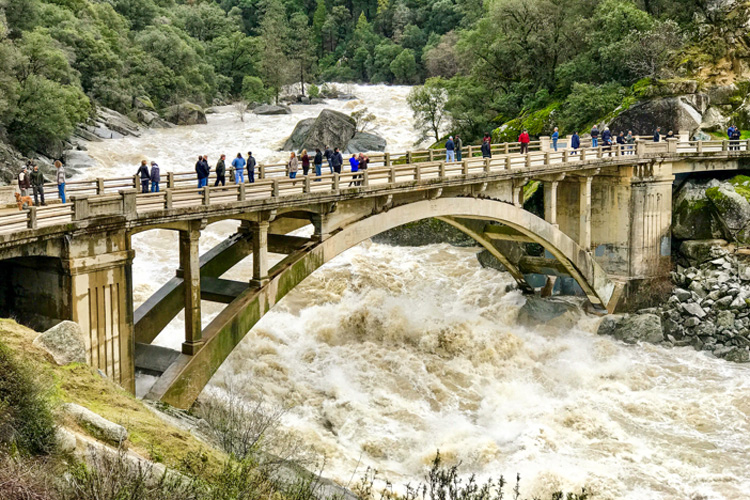
During January 2017, a rain-on-snow event caused flooding along the South Fork of the Yuba River in California. Climate change is expected to make such events larger and more frequent. (Photo credit: JD Richey)
Research conducted at UC Berkeley's Central Sierra Snow Laboratory (CSSL) is providing a much-needed tool for state water managers that could help them prepare for potential flooding during rain-on-snow events in the Sierra Nevada.
Rain that falls on and melts an existing snowpack is becoming more common throughout the year with climate change and has resulted in some of the region's biggest and most damaging floods. Minute-by-minute decisions by California and Nevada water resource managers during winter storms can have long-lasting impacts on people, property and water supplies, yet they have little guidance on how to mitigate flood risk during times of rapidly changing snowpack.
The new research, published recently in the open-access journal iScience, provides the first framework for a snowpack decision support tool, using hourly data from existing snow monitoring stations like those at CSSL. The study was led by the Desert Research Institute (DRI), in collaboration with teams from UC Berkeley, the National Weather Service and the University of Nevada, Reno.
"During rain-on-snow events, the people managing our water resources always have decisions to make, and it's really challenging when you're dealing with people's lives and property and livelihood," said lead author Anne Heggli, a DRI graduate assistant. "With this work, we're leveraging existing monitoring networks to maximize the investment that has already been made and to give the data new meaning as we work to solve existing problems that will potentially become larger as we confront climate change."
To develop a testable framework for a decision support tool, Heggli and her colleagues used hourly soil moisture data from the snow lab from 2006 to 2019 to identify periods of terrestrial water input. Next, they developed quality control procedures to improve model accuracy. From their results, they learned lessons about midwinter runoff that can be used to develop the framework for a more broadly applicable snowpack runoff decision support tool.
One finding is that snowmelt is not a primary source of runoff during rain-on-snow events when the snowpack is deep. In fact, the water content of the snow can increase during such events, even as most of the rainwater fills streams and potentially creates unseasonal flooding. The team concluded that hourly monitoring of the snowpack and water content in the soil during rain-on-snow events can help to predict the runoff.

Lead author Anne Heggli of the Desert Research Institute digs through deep snow to reach a monitoring site during a 2019 field project at the UC Berkeley Central Sierra Snow Laboratory in the Tahoe National Forest.
(Photo credit: M. Heggli)
"This study and the runoff decision framework that has been built from its data are great examples of the research-to-operations focus that has been so important at the Central Sierra Snow Lab for the past 75 years," said study co-author Andrew Schwartz of UC Berkeley, manager of the snow lab. "This work can help inform decisions by water managers as the climate and our water resources change, and that's the goal - to have better tools available for our water."
The results of this study can next be used to develop basin-specific decision support systems that will provide real-time guidance for water resource managers. The study results will also be used in a new project with the Nevada Department of Transportation.
"Anne's work, inspired by observation, demonstrates how much we still can learn from creatively analyzing existing data to produce actionable information supporting resource management during high-impact weather events, as well as the value of continued investment to maintain and expand our environmental networks," said co-author Benjamin Hatchett, DRI assistant research professor of atmospheric science.







